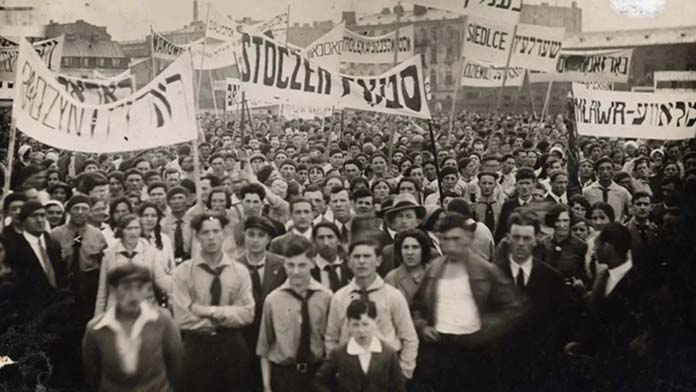Clare Fester reviews a new book that looks at the history of Jewish working class radicalism and struggle that Zionism has sought to hide
The Radical Jewish Tradition tells the inspiring and lesser-known story of working class Jews—together with their non-Jewish neighbours—who took on the bosses, the Czars and the fascists.
Broken into four sections, the book first makes the case that antisemitism is socially constructed to serve the unequal society we live in, not an immutable hatred that is generated from below and impossible to defeat.
In section two the authors share rich stories about the history of Jewish radicalism—from the barricades in revolutionary Russia to London’s anti-fascist Battle for Cable Street, from the garment strikes on New York’s Lower East Side to the Jewish-led self-defence militias of Poland.
The third section tells about counterrevolution in Germany laying the foundations for fascism and details how the Nazis imposed antisemitism from above (rather than it being a mass movement from below), as well as the proud history of Jewish resistance in the most difficult of circumstances: in the ghettos of Nazi-occupied Europe.
Finally, the book looks at the settlement of Palestine and establishment of the Israeli state, where Zionism—particularly its left wing—hammered “the final nail in the coffin of the remarkable phenomenon of mass Jewish radicalism”.
Timely
As Israel’s genocidal campaign in Gaza enters its sixth month, the book is a timely reminder that Zionism, the Holocaust, the Nakba and the horrors beamed into our phones 24/7 since 7 October were not foregone conclusions. As the writers show, Jews were involved (and often statistically over-represented) in every major European revolutionary movement, and it was these movements that offered real possibilities for ending anti-Jewish racism and the system that relies on it.
Today a generation of Jews are breaking with the Zionist consensus that has existed since the end of the Second World War, unmasking the Israeli apartheid state for what it is, and reckoning with the lies they were told about a settler state in the Middle East ensuring Jewish safety. The stories that Gluckstein and Stone tell were not only cut short by genocide—Zionism forcibly removed them from the canon of Jewish history.
The book is recommended reading for all Jewish people scouring their histories for alternatives to Zionism. But it is meant for a more general audience, too. All readers interested in uncovering the roots of racism, understanding the way ruling classes need scapegoats to divide and rule and learning strategies for cross-cultural movements against oppression, will get something out of The Radical Jewish Tradition.
Zionism
One of the book’s most valuable contributions is its argument that Zionism has never had a strategy or practice of fighting anti-Jewish racism. In every case study, Gluckstein and Stone show how Zionist organisations and theorists ignored, discouraged and undermined any fight against antisemitism in Europe and the US, especially movements that united Jews and non-Jews.
This is one of many reasons that Zionism as an ideology and migration to Palestine as a practice were supremely unpopular among most Jews for a long time—they offered nothing to improve the lives of oppressed Jews in Europe.
In Britain the Zionists discouraged Jews from joining the victorious Battle for Cable Street, where tens of thousands of demonstrators sent the British Union of Fascists packing. The Revisionist Zionists (the movement’s right flank and the forebearer of Benjamin Netanyahu’s Likud party) categorically believed antisemitism could not be defeated in Europe. In fact, they backed virulently antisemitic Polish nationalism—illustrated in the book with the anecdote that their members would sing the Polish national anthem while they beat up Jewish socialists. They agreed with the antisemites that Jews never belonged in Europe in the first place.
Labor Zionism
This was not only a limitation of right wing or general/mainstream Zionism. When Nazis famously rallied in New York’s Madison Square Garden in 1939, one labour Zionist organisation declined to counterprotest. “Sorry we can’t join you … Our Zionist policy is to take no part in politics outside Palestine.”
Critics may complain that the book gives labour Zionism short shrift, arguing there is a qualitative difference between left wing Zionism and the far right Zionism that dominates Israel today. But as the book explains, even Zionism’s left flank was primarily a middle class movement that concerned itself with removing Jews from Europe, rather than fighting for a Europe where Jews belonged.
The book’s argument is not that labour Zionists never participated in struggle—the authors share many examples where they did. The issue is that labour Zionism was always caught in the contradiction between socialism and nationalism, and nationalism won.
Founded by labour Zionists, the Israeli trade union federation was one of the largest in the world. But it led the charge excluding Arab labour from the Israeli economy, removing any possibility ofJews and Palestinians uniting as one multi-ethnic working class.
Labour Zionism built “socialist” agricultural settlements (kibbutzim), but they were the leading force in the expropriation of Palestinian land. Combined, the kibbutzim and labour Zionist parties have supplied 65 per cent of Israel’s military chiefs and many of its generals. In Europe, Jewish self-defence militias were the bulwark against racist violence. In Palestine they became the opposite. The paramilitary precursor to the Israeli Defense Forces, the Haganah, was created to protect the kibbutzim. It led the expulsion of Palestinians in 1948 and was far larger than any right wing Zionist militia.
The section exploring the role of labour Zionism in the colonisation of Palestine is among the book’s shorter chapters. The role of labour Zionism in colonising Palestine could be spelled out in more detail, particularly for a general audience less familiar with the subject matter. What is more, the leaders of key Jewish anti-occupation organisations in the US like IfNotNow come from the labour Zionist summer camps. Thorough accounts of the movement’s limitations would help clarify which political traditions are capable of confronting both anti-Jewish and anti-Arab racism as these current formations grow.
The Left
In the context of an inane and specious campaign that claims there is a dangerous form of “left antisemitism” on the rise today, The Radical Jewish Tradition performs a political rescue mission. In numerous case studies, the authors show how socialists, communists, anarchists, unionists and leftists of all sorts believed antisemitism was a real threat to working people everywhere and took the fight against it very seriously. How else can we explain the proportionally large presence of Jews in left parties, organisations and at the ballot box through the first half of the 20th century?
As the book demonstrates, it was their commitment to fighting antisemitism that made the left popular—more popular than Zionism—among Jewish people. On the eve of the Second World War in Eastern Europe, the Jewish Labour Bund was the most popular Jewish party and union movement in history.
The book recounts proud moments of this history, Cable Street being the best known. One honorable mention is the 1936 day-long strike and demonstration called by the Jewish Labor Bund responding to a pogrom in the town of Przytyk. A quarter of a million people joined, including non-Jewish Poles organised in the Polish Socialist Party. Years of groundwork between the two organisations allowed working class Poles and Jews to see their common cause and fight the right together—chipping away at the Zionist myth that antisemitism cannot be fought.
Another is the story of the Minsk ghetto, where Jews were highly integrated in a multi-ethnic society and resisted the Nazis together with their Belarusian (and many other nationalities) neighbours.
The authors point out that exploitation and oppression will not automatically teach people how to act in solidarity. Stalinism, sectarianism, nationalism and reformism—on all sides—undermined collaboration between Jews and non-Jews many times over.
Gluckstein and Stone don’t tell about these moments of joint resistance to paint a rosy revisionist history . They do so to point to the possibility of anti-racist solidarity through class struggle. It was that kind of struggle that could fight back antisemitism and the capitalist system that breeds it in the 20th century and that remains the key to defeating them today.
Relevant
More than an academic study, The Radical Jewish Tradition offers important strategic notes for today’s Jewish left. Particularly in the US, there is a burgeoning and somewhat romanticised interest in resurrecting the politics of organizations like the Jewish Labour Bund as an alternative to Zionism. But the book touches on how even nationalism rooted in the diaspora, as opposed to Israel, still comes with pitfalls. For all the outstanding work it did, the Bund’s ideas about “national cultural autonomy” often undermined class struggle across national boundaries.
In fact, early Russian revolutionary Georgi Plekhanov labeled the Bund “Zionists afraid of seasickness”—meaning that they didn’t want to leave Europe for Palestine, but they were nationalists nevertheless.
Much more could be teased out about the Bund’s limitations, including its economism, federalism and relationship with Austro-Marxism. But if these chapters inspire more people to do their own critical reading about the politics of the Bund, that is all to the good.
The Radical Jewish Tradition tells us about some of the best, most inspiring moments in struggle when Jews and non-Jews fought together as a class for a better world. Gluckstein and Stone show how Jewish radicalism not only fought immediate threats of exploitation, antisemitism and fascism. It also fed into movements against other types of racism, for tenant rights, for women’s liberation and more.
There are many more stories to tell—about the Lithuanian librarians who smuggled weapons into the Nazi ghettos, the Polish nuns who provided Jewish safe houses, the Bund-led multi-ethnic strikes of tannery workers in the Russian Empire, the immigrants from 50-plus nationalities who struck in the Lawrence, Massachusetts textile mills, and Black-Jewish solidarity beyond Harlem—to say nothing of the movements involving radical Jews in France, Spain, Argentina, Iraq and elsewhere. The book initiates readers into this forgotten history.
As the authors say, “The battle for memory is also a battle for the present.” The Zionists don’t want us to know there is a different answer to antisemitism than the Israeli state. The ruling class doesn’t want us to know there are ways to defeat their divide and rule scapegoating. The Radical Jewish Tradition sets the record straight.
By Clare Fester
The Radical Jewish Tradition: Revolutionaries, Resistance Fighters and Firebrands
By Donny Gluckstein and Janey Stone
Bookmarks, 2023 / Interventions, 2024






